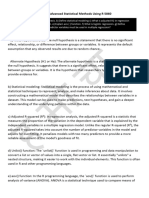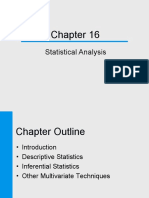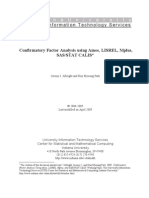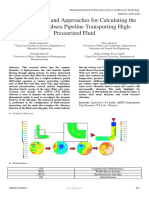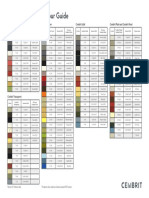SmartPLS Utilities
Uploaded by
plsmanSmartPLS Utilities
Uploaded by
plsmanOnline calculation for the Sobel Test (see http://www.people.
Calculation for the Sobel test: An interactive calculation tool for mediation tests Kristopher J. Preacher (University of Kansas)
Geoffrey J. Leonardelli (University of Toronto)
Purpose of Sobel test To test whether a mediator carries the influence of an IV to a DV. A word to the wise
The Sobel test works well only in large samples. We recommend using this test only if the user has no access to raw data. I assumptions. Consult Preacher and Hayes (2004, 2008) for details and easy-to-use macros that run the necessary regressio
Preacher, K. J., & Hayes, A. F. (2008). Asymptotic and resampling strategies for assessing and compar Preacher, K. J., & Hayes, A. F. (2004). SPSS and SAS procedures for estimating indirect effects in simp
See also:
SPSS and SAS macros for bootstrapping mediation effects SPSS and SAS macros for bootstrapping multiple mediation effects SPSS macro for bootstrapping moderated mediation effects
Mediation effects
A variable may be considered a mediator to the extent to which it carries the influence of a given independent variable (IV) significantly affects the mediator, (2) the IV significantly affects the DV in the absence of the mediator, (3) the mediator ha the mediator to the model. These criteria can be used to informally judge whether or not mediation is occurring, but MacKin by which mediation may be formally assessed.
An illustration of mediation a, b, and c' are path coefficients. Values in parentheses are standard errors of those path coefficients. Description of numbers needed a = raw (unstandardized) regression coefficient for the association between IV and mediator. sa = standard error of a. b = raw coefficient for the association between the mediator and the DV (when the IV is also a predictor of the DV). sb = standard error of b. To get numbers 1. Run a regression analysis with the IV predicting the mediator. This will give a and sa.
2. Run a regression analysis with the IV and mediator predicting the DV. This will give b and sb. Note that sa and sb sho Sobel test equation z-value = a*b/SQRT(b2*sa2 + a2*sb2) Aroian test equation z-value = a*b/SQRT(b2*sa2 + a2*sb2 + sa2*sb2) Goodman test equation
z-value = a*b/SQRT(b2*sa2 + a2*sb2 - sa2*sb2)
The Sobel test equation omits the third term of the variance estimate in the denominator. We recommend using the Aroian assumption that the product of sa and sb is vanishingly small. The Goodman version of the test subtracts the third term for a effect of yielding a negative variance estimate. References
The Sobel test and the Aroian test seemed to perform best in a Monte Carlo study (MacKinnon, Warsi, & Dwyer, 1995), and
Aroian, L. A. (1944/1947). The probability function of the product of two normally distributed variables. Annals of Mathema
Baron, R. M., & Kenny, D. A. (1986). The moderator-mediator variable distinction in social psychological research: Concept Goodman, L. A. (1960). On the exact variance of products. Journal of the American Statistical Association, 55, 708-713.
Hoyle, R. H., & Kenny, D. A. (1999). Sample size, reliability, and tests of statistical mediation. In R. Hoyle (Ed.) Statistical S
Krull, J. L., & MacKinnon, D. P. (1999). Multilevel mediation modeling in group-based intervention studies. Evaluation Revie
MacKinnon, D. P., & Dwyer, J. H. (1993). Estimating mediated effects in prevention studies. Evaluation Review, 17, 144-15
MacKinnon, D. P., Lockwood, C. M., Hoffman, J. M., West, S. G., & Sheets, V. (2002). A comparison of methods to test med
MacKinnon, D. P., Warsi, G., & Dwyer, J. H. (1995). A simulation study of mediated effect measures. Multivariate Behaviora
Preacher, K. J., & Hayes, A. F. (2004). SPSS and SAS procedures for estimating indirect effects in simp
Shrout, P. E., & Bolger, N. (2002). Mediation in experimental and nonexperimental studies: New procedures and recommen Acknowledgments
Sobel, M. E. (1982). Asymptotic intervals for indirect effects in structural equations models. In S. Leinhart (Ed.), Sociologic
Original version posted March, 2001. We wish to thank David MacKinnon and David Kenny for advice which made this intera
www.people.ku.edu/~preacher/sobel/sobel.htm)
s no access to raw data. If you have the raw data, bootstrapping offers a much better alternative that imposes no distributional n the necessary regression analyses for you:
ssessing and comparing indirect effects in multiple mediator models. Behavior Research Methods, 40, 879-891. direct effects in simple mediation models. Behavior Research Methods, Instruments, & Computers, 36, 717-731.
ndependent variable (IV) to a given dependent variable (DV). Generally speaking, mediation can be said to occur when (1) the IV ator, (3) the mediator has a significant unique effect on the DV, and (4) the effect of the IV on the DV shrinks upon the addition of n is occurring, but MacKinnon & Dwyer (1993) and MacKinnon, Warsi, & Dwyer (1995) have popularized statistically based methods
edictor of the DV).
. Note that sa and sb should never be negative.
mmend using the Aroian version of the Sobel test suggested in Baron and Kenny (1986) because it does not make the unnecessary tracts the third term for an unbiased estimate of the variance of the mediated effect, but this can sometimes have the unfortunate
arsi, & Dwyer, 1995), and converge closely with sample sizes greater than 50 or so.
ables. Annals of Mathematical Statistics, 18, 265-271.
ogical research: Conceptual, strategic, and statistical considerations. Journal of Personality and Social Psychology, 51, 1173-1182.
ociation, 55, 708-713.
R. Hoyle (Ed.) Statistical Strategies for Small Sample Research. Thousand Oaks, CA: Sage Publications.
studies. Evaluation Review, 23, 418-444.
ation Review, 17, 144-158.
on of methods to test mediation and other intervening variable effects. Psychological Methods, 7, 83-104.
es. Multivariate Behavioral Research, 30, 41-62.
direct effects in simple mediation models. Behavior Research Methods, Instruments, & Computers, 36, 717-731.
rocedures and recommendations. Psychological Methods, 7, 422-445.
Leinhart (Ed.), Sociological methodology 1982 (pp.290-312). San Francisco: Jossey-Bass.
ce which made this interactive web page possible. Free JavaScripts provided by The JavaScript Source and John C. Pezzullo.
s no distributional
ethods, 40, 879-891. mputers, 36, 717-731.
cur when (1) the IV upon the addition of tically based methods
make the unnecessary have the unfortunate
ogy, 51, 1173-1182.
mputers, 36, 717-731.
hn C. Pezzullo.
On this page, we link to a number of web-based, T-value --> P-value conversion c Please remember that the degrees of freedom (DoF) is simply the number of boot So if you resample your bootstrap 200 times, the degrees of freedom is 199 (rega Also, we do not warranty (or guarantee) that any of the results computed by these #1: This first calculator tells you the one-tailed and two-tailed probability values of Please supply the necessary parameters, and then click the 'calculate' button:
#2: This second calculator is much more versatile than the first. It calculates a num chi-square to P, t to P, F to P, Fisher r-to-z transformation, and a couple of others
value conversion calculators, both one-tailed and two-tailed. he number of bootstrap resamples minus 1. edom is 199 (regardless of your original sample size). computed by these websites are correct (although it is easy to check!)
obability values of a t-test, given the t-value and the degrees of freedom. lculate' button: It calculates a number of statistical conversions, including z to P, a couple of others:
Cohen, J. (1992). A power primer Psychological Bulletin, 112, 155-
1) Select the partial regression m with the largest number of predictive latent constructs ( indicators) in 'Mult R' (3 in this example).
2) Select the desired (alpha) le < 0.05 in this example).
3) Select the desired effect size (medium in this example).
4) Find the N in the correspondin and column (76 in this example)
5) These heuristics indicate that need a minimum sample size to have adequate power for your purposes.
6) NOTE: This minimum sample s = 76) is a reasonable starting to achieve your desired power.
A power primer. etin, 112, 155-159.
al regression model number of t constructs (or R' (3 in this
ed (alpha) level (p mple).
ed effect size xample).
e corresponding row this example).
s indicate that you m sample size of 76 power for your
mum sample size (N able starting point sired power.
You might also like
- DBA-5102 Statistics - For - Management AssignmentNo ratings yetDBA-5102 Statistics - For - Management Assignment12 pages
- A Consistent Model Specification Test With Mixed Discrete and Continuous DataNo ratings yetA Consistent Model Specification Test With Mixed Discrete and Continuous Data25 pages
- Does Matching Overcome LaLondes CritiqueNo ratings yetDoes Matching Overcome LaLondes Critique49 pages
- Mediation analysis and Path analysis_MA_2020No ratings yetMediation analysis and Path analysis_MA_202064 pages
- Nonparametric Effect Size Estimators: East Carolina UniversityNo ratings yetNonparametric Effect Size Estimators: East Carolina University2 pages
- MIDAS Stata Module For Meta-Analytical IntegrationNo ratings yetMIDAS Stata Module For Meta-Analytical Integration25 pages
- Presenting The Results of A Multiple Regression AnalysisNo ratings yetPresenting The Results of A Multiple Regression Analysis4 pages
- IOER Descriptive and Inferential Gonzales NepthalieNo ratings yetIOER Descriptive and Inferential Gonzales Nepthalie39 pages
- Statistical Tests of Models That Include Mediating VariablesNo ratings yetStatistical Tests of Models That Include Mediating Variables14 pages
- Four Assumptions Test in Multiple RegressionNo ratings yetFour Assumptions Test in Multiple Regression10 pages
- SPSS and SAS Procedures For Estimating Indirect Effects in Simple Mediation ModelsNo ratings yetSPSS and SAS Procedures For Estimating Indirect Effects in Simple Mediation Models26 pages
- The Superiority of Simple Alternatives To Regression For Social Science PredictionsNo ratings yetThe Superiority of Simple Alternatives To Regression For Social Science Predictions16 pages
- Journal of Statistical Computation and SimulationNo ratings yetJournal of Statistical Computation and Simulation18 pages
- Comparative Study of Ratio and Regression Estimators Using Double Sampling For Estimation of Population MeanNo ratings yetComparative Study of Ratio and Regression Estimators Using Double Sampling For Estimation of Population Mean7 pages
- WilmotOnes Agreeableness SupplementalmaterialsNo ratings yetWilmotOnes Agreeableness Supplementalmaterials85 pages
- Regression Analysis ANOVA Results SS DF MS F PNo ratings yetRegression Analysis ANOVA Results SS DF MS F P4 pages
- Ness Evans, Annabel-Using Basic Statistics in The Behavioral and Social Sciences-Chapter 2No ratings yetNess Evans, Annabel-Using Basic Statistics in The Behavioral and Social Sciences-Chapter 217 pages
- Confirmatory Factor Analysis Using Amos, LISREL, Mplus100% (1)Confirmatory Factor Analysis Using Amos, LISREL, Mplus86 pages
- Comparison of Imputation Techniques After Classifying The Dataset Using KNN Classifier For The Imputation of Missing DataNo ratings yetComparison of Imputation Techniques After Classifying The Dataset Using KNN Classifier For The Imputation of Missing Data4 pages
- STats - Descriptive and Inferential DivisionsNo ratings yetSTats - Descriptive and Inferential Divisions4 pages
- Judd et al. - Supplemental Appendix to Experiments with More Than One Random FactorNo ratings yetJudd et al. - Supplemental Appendix to Experiments with More Than One Random Factor38 pages
- Asymptotic and Resampling Strategies For Assessing and Comparing Indirect Effects in Multiple Mediator ModelsNo ratings yetAsymptotic and Resampling Strategies For Assessing and Comparing Indirect Effects in Multiple Mediator Models13 pages
- Analysingn quantitative data Mbizi modifNo ratings yetAnalysingn quantitative data Mbizi modif38 pages
- A Tutorial On Conducting and Interpreting A Bayesian ANOVA in JASPNo ratings yetA Tutorial On Conducting and Interpreting A Bayesian ANOVA in JASP22 pages
- Sample Size for Analytical Surveys, Using a Pretest-Posttest-Comparison-Group DesignFrom EverandSample Size for Analytical Surveys, Using a Pretest-Posttest-Comparison-Group DesignNo ratings yet
- ALMCO Risk Assessment Kitchen & Dinning Area-JAN 2021No ratings yetALMCO Risk Assessment Kitchen & Dinning Area-JAN 202110 pages
- Module 2 - Handout 2.0 - Demand Theory, Analysis and EstimationNo ratings yetModule 2 - Handout 2.0 - Demand Theory, Analysis and Estimation4 pages
- Burying The Dead': Making Muslim Space in Britain : Humayun AnsariNo ratings yetBurying The Dead': Making Muslim Space in Britain : Humayun Ansari22 pages
- CFD Modeling and Approaches For Calculating The Losses of A Subsea Pipeline Transporting HighPressurized FluidNo ratings yetCFD Modeling and Approaches For Calculating The Losses of A Subsea Pipeline Transporting HighPressurized Fluid7 pages
- Bleaching Our Roots: Race and Culture in American Popular MusicNo ratings yetBleaching Our Roots: Race and Culture in American Popular Music258 pages
- BS 476-3-1975 - Fire Test On Building Materials & Structures - Part 3 - External Fire Exposure Roof TestsNo ratings yetBS 476-3-1975 - Fire Test On Building Materials & Structures - Part 3 - External Fire Exposure Roof Tests14 pages
- Medical Center Map - Directions - Hotel Information PDFNo ratings yetMedical Center Map - Directions - Hotel Information PDF3 pages
- Mental Models: An Interdisciplinary Synthesis of Theory and MethodsNo ratings yetMental Models: An Interdisciplinary Synthesis of Theory and Methods13 pages
- A Consistent Model Specification Test With Mixed Discrete and Continuous DataA Consistent Model Specification Test With Mixed Discrete and Continuous Data
- Nonparametric Effect Size Estimators: East Carolina UniversityNonparametric Effect Size Estimators: East Carolina University
- MIDAS Stata Module For Meta-Analytical IntegrationMIDAS Stata Module For Meta-Analytical Integration
- Presenting The Results of A Multiple Regression AnalysisPresenting The Results of A Multiple Regression Analysis
- IOER Descriptive and Inferential Gonzales NepthalieIOER Descriptive and Inferential Gonzales Nepthalie
- Statistical Tests of Models That Include Mediating VariablesStatistical Tests of Models That Include Mediating Variables
- SPSS and SAS Procedures For Estimating Indirect Effects in Simple Mediation ModelsSPSS and SAS Procedures For Estimating Indirect Effects in Simple Mediation Models
- The Superiority of Simple Alternatives To Regression For Social Science PredictionsThe Superiority of Simple Alternatives To Regression For Social Science Predictions
- Comparative Study of Ratio and Regression Estimators Using Double Sampling For Estimation of Population MeanComparative Study of Ratio and Regression Estimators Using Double Sampling For Estimation of Population Mean
- Ness Evans, Annabel-Using Basic Statistics in The Behavioral and Social Sciences-Chapter 2Ness Evans, Annabel-Using Basic Statistics in The Behavioral and Social Sciences-Chapter 2
- Confirmatory Factor Analysis Using Amos, LISREL, MplusConfirmatory Factor Analysis Using Amos, LISREL, Mplus
- Comparison of Imputation Techniques After Classifying The Dataset Using KNN Classifier For The Imputation of Missing DataComparison of Imputation Techniques After Classifying The Dataset Using KNN Classifier For The Imputation of Missing Data
- Judd et al. - Supplemental Appendix to Experiments with More Than One Random FactorJudd et al. - Supplemental Appendix to Experiments with More Than One Random Factor
- Asymptotic and Resampling Strategies For Assessing and Comparing Indirect Effects in Multiple Mediator ModelsAsymptotic and Resampling Strategies For Assessing and Comparing Indirect Effects in Multiple Mediator Models
- A Tutorial On Conducting and Interpreting A Bayesian ANOVA in JASPA Tutorial On Conducting and Interpreting A Bayesian ANOVA in JASP
- Introduction To Non Parametric Methods Through R SoftwareFrom EverandIntroduction To Non Parametric Methods Through R Software
- Sample Size for Analytical Surveys, Using a Pretest-Posttest-Comparison-Group DesignFrom EverandSample Size for Analytical Surveys, Using a Pretest-Posttest-Comparison-Group Design
- ALMCO Risk Assessment Kitchen & Dinning Area-JAN 2021ALMCO Risk Assessment Kitchen & Dinning Area-JAN 2021
- Module 2 - Handout 2.0 - Demand Theory, Analysis and EstimationModule 2 - Handout 2.0 - Demand Theory, Analysis and Estimation
- Burying The Dead': Making Muslim Space in Britain : Humayun AnsariBurying The Dead': Making Muslim Space in Britain : Humayun Ansari
- CFD Modeling and Approaches For Calculating The Losses of A Subsea Pipeline Transporting HighPressurized FluidCFD Modeling and Approaches For Calculating The Losses of A Subsea Pipeline Transporting HighPressurized Fluid
- Bleaching Our Roots: Race and Culture in American Popular MusicBleaching Our Roots: Race and Culture in American Popular Music
- BS 476-3-1975 - Fire Test On Building Materials & Structures - Part 3 - External Fire Exposure Roof TestsBS 476-3-1975 - Fire Test On Building Materials & Structures - Part 3 - External Fire Exposure Roof Tests
- Medical Center Map - Directions - Hotel Information PDFMedical Center Map - Directions - Hotel Information PDF
- Mental Models: An Interdisciplinary Synthesis of Theory and MethodsMental Models: An Interdisciplinary Synthesis of Theory and Methods





